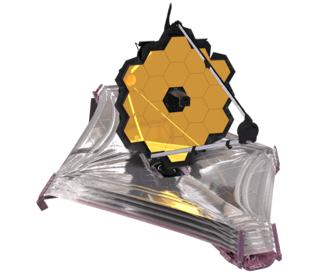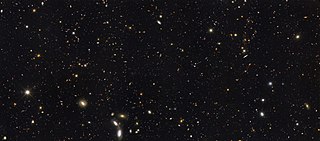Related Research Articles
The following is a timeline of galaxies, clusters of galaxies, and large-scale structure of the universe.

The James Webb Space Telescope (JWST) is a space telescope currently conducting infrared astronomy. As the largest optical telescope in space, it is equipped with high-resolution and high-sensitivity instruments, allowing it to view objects too old, distant, or faint for the Hubble Space Telescope. This enables investigations across many fields of astronomy and cosmology, such as observation of the first stars, the formation of the first galaxies, and detailed atmospheric characterization of potentially habitable exoplanets.

An astronomical survey is a general map or image of a region of the sky that lacks a specific observational target. Alternatively, an astronomical survey may comprise a set of images, spectra, or other observations of objects that share a common type or feature. Surveys are often restricted to one band of the electromagnetic spectrum due to instrumental limitations, although multiwavelength surveys can be made by using multiple detectors, each sensitive to a different bandwidth.
Luminous infrared galaxies or LIRGs are galaxies with luminosities, the measurement of brightness, above 1011 L☉. They are also referred to as submillimeter galaxies (SMGs) through their normal method of detection. LIRGs are more abundant than starburst galaxies, Seyfert galaxies and quasi-stellar objects at comparable luminosity. Infrared galaxies emit more energy in the infrared than at all other wavelengths combined. A LIRG's luminosity is 100 billion times that of the Sun.

The Great Observatories Origins Deep Survey, or GOODS, is an astronomical survey combining deep observations from three of NASA's Great Observatories: the Hubble Space Telescope, the Spitzer Space Telescope, and the Chandra X-ray Observatory, along with data from other space-based telescopes, such as XMM Newton, and some of the world's most powerful ground-based telescopes.
Nicholas Zabriskie "Nick" Scoville is the Francis L. Moseley Professor of Astronomy at Caltech.
George Henry Rieke, a noted American infrared astronomer, is former Deputy Director of the Steward Observatory and Regents Professor of Astronomy and Planetary Sciences at the University of Arizona in Tucson. He led the experiment design and development team for the Multiband Imaging Photometer for Spitzer (MIPS) instrument on NASA's infrared Spitzer Space Telescope, and currently chairs the science team of the Mid-Infrared Instrument for the James Webb Space Telescope.
Tim Richard Walter Schrabback–Krahe is KIPAC Fellow at the Kavli Institute of Particle Astrophysics and Cosmology, which is based at Stanford University. He is working within the X-ray Astronomy and Observational Cosmology Group. His research focuses on weak gravitational lensing and its applications for cosmology and astrophysics.
MACS0647-JD is a galaxy with a redshift of about z = 10.7, equivalent to a light travel distance of 13.26 billion light-years. If the distance estimate is correct, it formed about 427 million years after the Big Bang.

Simon John Lilly FRS is a Professor in the Department of Physics at ETH Zürich.

GN-z11 is a high-redshift galaxy found in the constellation Ursa Major. It was among the farthest known galaxies from Earth ever discovered. The 2015 discovery was published in a 2016 paper headed by Pascal Oesch and Gabriel Brammer. Up until the discovery of JADES-GS-z13-0 in 2022 by the James Webb Space Telescope, GN-z11 was the oldest and most distant known galaxy yet identified in the observable universe, having a spectroscopic redshift of z = 10.957, which corresponds to a proper distance of approximately 32 billion light-years.
Sangeeta Malhotra is an astrophysicist who studies galaxies, their contents, and their effects on the universe around them. The objects she studies range from our own Milky Way galaxy to some of the earliest and most distant known galaxies in the epoch of cosmic dawn.

Webb's First Deep Field is the first operational image taken by the James Webb Space Telescope. The deep-field photograph, which covers a tiny area of sky visible from the Southern Hemisphere, is centered on SMACS 0723, a galaxy cluster in the constellation of Volans. Thousands of galaxies are visible in the image, some as old as 13 billion years. The image is the highest-resolution image of the early universe ever taken. Captured by the telescope's Near-Infrared Camera (NIRCam), the image was revealed to the public by NASA on 11 July 2022.

SMACS J0723.3–7327, commonly referred to as SMACS 0723, is a galaxy cluster about 4 billion light years from Earth, within the southern constellation of Volans. It is a patch of sky visible from the Southern Hemisphere on Earth and often observed by the Hubble Space Telescope and other telescopes in search of the deep past. It was the target of the first full-color image to be unveiled by the James Webb Space Telescope (JWST), imaged using NIRCam, with spectra included, showing objects lensed by the cluster with redshifts implying they are 13.1 billion years old. The cluster has been previously observed by the Hubble Space Telescope (HST) as part of the Southern MAssive Cluster Survey (SMACS), as well as Planck and Chandra.

CEERS-93316 is a candidate high-redshift galaxy, with an estimated redshift of approximately z = 16.4, corresponding to 236 million years after the Big Bang. If confirmed, it would be one of the earliest and most distant known galaxies observed.
Viviana Acquaviva is an Italian astrophysicist who is a professor in the Department of Physics at the New York City College of Technology. Her research interests consider data science and machine learning for physics and astronomy. She was named one of Italy's most inspirational technologists in 2019.
F200DB-045 is a candidate high-redshift galaxy, with an estimated redshift of approximately z = 20.4, corresponding to 168 million years after the Big Bang. If confirmed, it would be one of the earliest and most distant known galaxies observed.
References
- ↑ Meg (2016-01-18). "Introducing Jeyhan Kartaltepe". astrotweeps. Retrieved 2023-03-29.
- ↑ Kartaltepe, Jeyhan Sevim (2009). "A multiwavelength study of (ultra)luminous infrared galaxies in the cosmos field".
- ↑ "Jeyhan Kartaltepe". www.sissa.it. Retrieved 2023-03-29.
- ↑ "People | LAMA | RIT". www.rit.edu. Retrieved 2023-03-29.
- ↑ "Team Members". ceers.github.io. Retrieved 2023-03-29.
- ↑ "Center for Computational Relativity and Gravitation (CCRG)". ccrg.rit.edu. Retrieved 2023-03-29.
- ↑ "James Webb Space Telescope study reveals wide diversity of galaxies in the early universe". EurekAlert!. Retrieved 2023-03-29.
- 1 2 3 Jenner, Lynn (2021-08-17). "Mapping the Universe's Earliest Structures with COSMOS-Webb". NASA. Retrieved 2023-03-29.
- ↑ Webb, Stephen (2012), "A new messenger from the cosmos", New Eyes on the Universe, New York, NY: Springer New York, pp. 203–226, ISBN 978-1-4614-2193-1 , retrieved 2023-03-29
- ↑ "Home Page". COSMOS. Retrieved 2023-03-29.
- 1 2 "How the James Webb Space Telescope has revealed a surprisingly bright, complex and element-filled early universe | Technology". Devdiscourse. Retrieved 2023-03-29.
- ↑ O'Callaghan, Jonathan. "The James Webb Space Telescope’s First Year of Extraordinary Science Has Been Revealed". Scientific American. Retrieved 2023-03-29.
- ↑ "Our universe mastered the art of making galaxies while it was still young". Popular Science. 2023-01-16. Retrieved 2023-03-29.